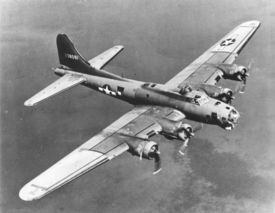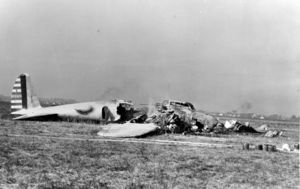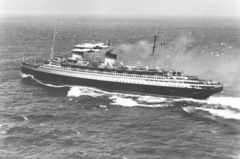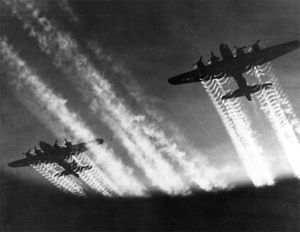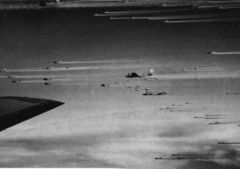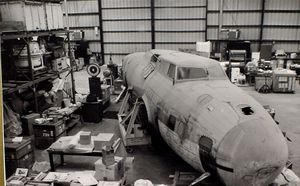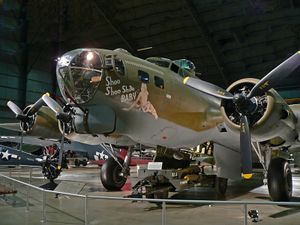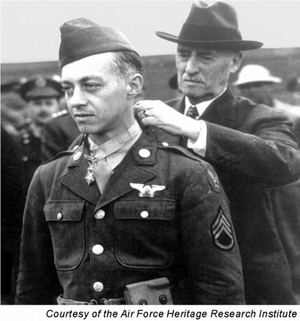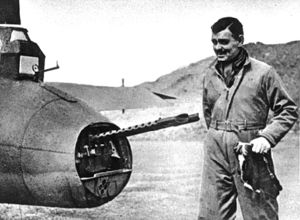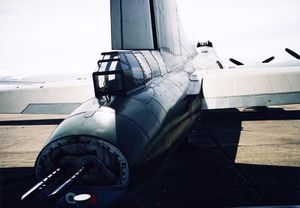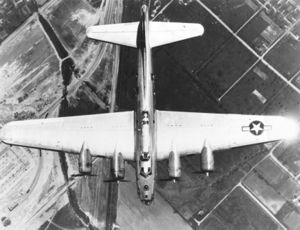PlaneSpottingWorld welcomes all new members! Please gives your ideas at the Terminal.
B-17 Flying Fortress
| B-17 Flying Fortress | |
|---|---|
| USAAF B-17G-30-DL on a bomb run. | |
| Type | Strategic bomber |
| Manufacturer | Boeing |
| Designed by | Edward C. Wells E. Gifford Emery |
| Maiden flight | 28 July 1935[1] |
| Introduced | April 1938 |
| Retired | 1968 (Brazilian Air Force) |
| Status | Retired (14 airframes currently in flying condition[2]) |
| Primary users | United States Army Air Force Royal Air Force Israeli Air Force |
| Produced | 1936–1945 |
| Number built | 12,731[3] |
| Unit cost | US$238,329[4] |
| Variants | XB-38 YB-40 C-108 |
The Boeing B-17 Flying Fortress is an American four-engine heavy bomber aircraft developed for the US Army Air Corps (USAAC). Competing against Douglas and Martin for a contract to build 200 planes, the Boeing entry outperformed both the other competitors and more than met the Air Corps' expectations. Although losing the contract due to an accident, regardless, the Air Corps was so impressed with Boeing's design that they ordered 13 B-17s. The B-17 Flying Fortress went on to enter full-scale production and was considered the first truly mass-produced large aircraft, eventually evolving through numerous design advancements, from B-17A to G.
The B-17 was primarily employed in the daylight precision strategic bombing campaign of World War II against German industrial targets. The United States Eighth Air Force based in England and the Fifteenth Air Force based in Italy complemented the RAF Bomber Command's nighttime area bombing in Operation Pointblank, to help secure air superiority over the cities, factories and battlefields of Western Europe in preparation for Operation Overlord.[5] The B-17 also participated, to a lesser extent, in the War in the Pacific.
From its pre-war inception, the USAAC touted the aircraft as a strategic weapon; it was a potent, high-flying, long-ranging bomber capable of unleashing great destruction yet able to defend itself. With the ability to return home despite extensive battle damage, its durability, especially in belly-landings and ditchings, quickly took on mythic proportions.[6][7][8] Stories and photos of B-17s surviving battle damage widely circulated, boosting its iconic status.[9] Despite an inferior range and bombload compared to the more numerous B-24 Liberator,[10] a survey of Eighth Air Force crews showed a much higher rate of satisfaction in the B-17.[11] With a service ceiling greater than any of its Allied contemporaries, the B-17 established itself as a superb weapons system, dropping more bombs than any other US aircraft in World War II. Of the 1.5 million tonnes of bombs dropped on Germany, 500,000 were dropped from B-17s.
Contents
Design and development
On 8 August 1934, the U.S. Army Air Corps (USAAC) tendered a proposal for a multi-engined bomber to replace the Martin B-10. Requirements were that it would carry a "useful bombload" at an altitude of 10,000 feet (3 km) for ten hours with a top speed of at least 200 mph (322 km/h).[12][13] They also desired, but did not require, a range of 2,000 miles (3200 km) and a speed of 250 mph (400 km/h). The Air Corps were looking for a bomber capable of reinforcing the air forces in Hawaii, Panama, and Alaska.[14] The competition would be decided by a "fly-off" at Wright Field in Dayton, Ohio. Boeing competed with the Douglas DB-1 and Martin Model 146 for the Air Corps contract.
The prototype B-17, designated Model 299, was designed by a team of engineers led by E. Gifford Emery and Edward Curtis Wells and built at Boeing's own expense.[13] It combined features of the experimental Boeing XB-15 bomber with the Boeing 247 transport airplane.[12] The first Boeing aircraft with a flight-deck instead of an open cockpit, the B-17 was armed with both bombs (up to 4,800 pounds (2180 kg), on two racks in the bomb bay behind the cockpit) and five 0.30 inch (7.62 mm) caliber machine guns, and was powered by Pratt & Whitney R-1690 radial engines each producing 750 Horsepower (600 kW) at 7,000 feet (2130 m).[13]
The first flight of the Model 299 was on 28 July 1935, with Boeing chief test-pilot Les Tower at the controls.[15][1] Richard Williams, a reporter for the Seattle Times coined the name "Flying Fortress" when the Model 299 was rolled out, bristling with multiple machine gun installations.[16] Boeing was quick to see the value of the name and had it trademarked for use. On 20 August, the prototype flew from Seattle to Wright Field in nine hours and three minutes at an average speed of 235 mph (378 km/h), much faster than the competition.[13]
At the fly-off, the four-engine Boeing design displayed superior performance over the twin-engine DB-1 and Model 146, and General Frank Maxwell Andrews of the GHQ Air Force believed that the long-range capabilities of four-engine large aircraft were more efficient than shorter-ranged twin-engined airplanes. His opinions were shared by the Air Corps procurement officers and, even before the competition was finished, they suggested buying 65 B-17s.[17]
Development continued on the Boeing Model 299, and on 30 October 1935, the Army Air Corps test-pilots Ployer, Hill, and Tower, took the Model 299 on a second evaluation flight. The crew forgot to disengage the airplane's "gust lock," a device that held the bomber's movable control surfaces in place while the plane was parked on the ground, and having taken off, the aircraft entered a steep climb, stalled, nosed over and crashed, killing the crew.[18][19]The crashed Model 299 could not finish the evaluation, and while the Air Corps was still enthusiastic about the aircraft's potential, Army officials were daunted by the much greater expense per aircraft.[20][21] Army Chief of Staff Malin Craig cancelled the order for 67 B-17s, and ordered 133 of the twin-engine Douglas B-18 Bolo instead.[17][13]
Regardless, the USAAC had been impressed by the prototype's performance and, on 17 January 1936, the Air Corps ordered, through a legal loophole,[22] 13 YB-17s for service testing. The YB-17 incorporated a number of significant changes from the Model 299, including more powerful Wright R-1820-39 Cyclone engines replacing the original Pratt & Whitney's.
On 1 March 1937, 12 of the 13 YB-17s were delivered to the 2nd Bombardment Group at Langley Field in Virginia, and used to help develop heavy bomber techniques and work out other bugs.[12] One suggestion was the use of a checklist, to avoid accidents such as the Model 299's.[23][22] In one of their first missions, three B-17s, following lead navigator Lt. Curtis LeMay, were sent by Admiral Andrews to "intercept" the Italian ocean liner Rex 800 miles (1290 km) off the Atlantic coast and take photographs. The successful mission was widely publicized.[24]
The 13th YB-17 was delivered to the Material Division at Wright Field, Ohio, to be used for flight testing.[25]
A 14th YB-17 (37-369), originally constructed for ground testing of the airframe's strength, was upgraded and fitted with exhaust-driven turbochargers. Scheduled to fly in 1937, it encountered problems with the turbochargers and its first flight was delayed until 29 April 1938.[26] Modifications cost Boeing US$100,000 and took until spring 1939 to complete, but resulted in an increased service ceiling and maximum speed.[27] The aircraft was delivered to the Army on 31 January 1939 and was redesignated B-17A to signify the first operational variant.[28]
In late 1937 the Air Corps ordered ten more planes, designated B-17B and, soon after, another 29.[27] Improved with larger flaps, rudder and Plexiglas nose, the B-17Bs were delivered between July 1939 and March 1940. They equipped two bombardment groups, one on each US coast.[29][30]
Prior to the attack on Pearl Harbor, fewer than 200 B-17s were in service with the Army,[22] but production quickly accelerated, and the B-17 became the first truly mass-produced large aircraft.[31][32] The aircraft went on to serve in every World War II combat zone, and by the time production ended in May 1945, 12,731 aircraft had been built by Boeing, Douglas and Vega (a subsidiary of Lockheed).[33]
Operational service
- See also: Maximum reported B-17 & B-24 bomb loads
The B-17 began operations in World War II with the RAF in 1941, USAAF Eighth Air Force and Fifteenth Air Force units in 1942, and was primarily involved in the daylight precision strategic bombing campaign against German industrial targets. Operation Pointblank guided attacks in preparation for a ground assault.[34]
The RAF
The Royal Air Force (RAF) entered World War II with no heavy bomber of its own and while by 1941, the Short Stirling and Handley Page Halifax had become its primary bombers, in early 1940, the RAF entered into an agreement with the US Army Air Corps to be provided with 20 B-17Cs, redesignated Fortress I. Their first operation was against Wilhelmshaven on 8 July 1941.[35][29][36] At the time, the Air Corps considered high-altitude flight to be 20,000 feet (6 km) but, to avoid being intercepted by fighter planes, the RAF bombed the naval barracks from 30,000 feet (9 km).[37] They were unable to hit their targets and temperatures were so low that the machine guns froze up.[38] On 24 July, they tried another target, Brest in France, but again missed completely.
By September, after the RAF had lost eight B-17Cs in combat or to accidents, Bomber Command had abandoned daylight bombing raids due to the Fortress I's poor performance. The remaining aircraft were transferred to different commands for deployment to various duties including coastal defence.[38] The experience had showed both the RAF and USAAF that the B-17C was not ready for combat, and that improved defenses, larger bombloads and more accurate bombing methods were required, which would be incorporated in later variations. Moreover, even with these improvements, it was the USAAF and not the RAF that was willing to remain faithful to using the B-17 as a "day" bomber.[37]
The USAAF
For the Air Corps (renamed United States Army Air Force or USAAF in 1941), the B-17 and other bombers were able to accurately bomb from high altitudes by the use of the then-secret Norden Bombsight, which was an optical electro-mechanical gyro-stabilized computer. During daylight bombing missions and sorties, the device was able to determine, from variables input by the bombardier, the point in space at which the bomber's ordnance type should be released to hit the target. The bombardier essentially took over flight control of the aircraft during the bomb run, maintaining a level attitude during the final moments.[39]
The USAAF began building up its air forces in Europe using B-17Es soon after entering the war. The first Eighth Air Force units arrived in High Wycombe, England on 12 May 1942, to form the 97th Bomb Group.[12] On 17 August 1942, 18 B-17Es of the 97th, including Yankee Doodle, flown by Brigadier General Ira Eaker, were escorted by RAF Spitfires on the first USAAF raid over Europe, against railroad marshalling yards at Rouen-Sotteville in France.[40][12] The operation was a success, with only minor damage to two aircraft.
Combined offensive
The two different strategies of the American and British Bomber commands were organized at the Casablanca Conference in January 1943. The resulting Operation Pointblank described a "Combined Bomber Offensive" that would weaken the Nazi Wehrmacht and establish air superiority in preparation of a ground offensive.[5]
Operation Pointblank opened with attacks on targets in Western Europe. General Ira C. Eaker and the Eighth Air Force placed highest priority on attacks on the German aircraft industry, especially fighter assembly plants, engine factories and ball-bearing manufacturers.[5]
On 17 April 1943, an attack on the Focke-Wulf plant at Bremen by 115 Fortresses met with little success. Sixteen aircraft were shot down, and 48 others were damaged.[41] The attacks did succeed, however, in diverting about half the Luftwaffe's fighter force to anti-bomber operations.
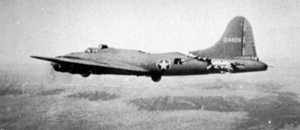
Since the airfield bombings were not appreciably reducing German fighter strength, as additional B-17 groups were formed, Eaker ordered major missions deeper into Germany against important industrial targets. The 8th Air Force then targeted the ball-bearing factories in Schweinfurt, hoping to cripple the war effort there. The first attack, on 17 August 1943 by 230 B-17s, was met by 300 Luftwaffe fighters. Thirty-six aircraft were downed, with the loss of 200 men, but the attack did not critically damage the factories.
A second attempt on 14 October 1943 would later come to be known as "Black Thursday".[42] Of the 291 attacking Fortresses, 59 were shot down over Germany, one ditched in the English Channel, five crashed in England, and 12 more were scrapped due to battle damage or crash-landings (more by AA guns than the Luftwaffe), a total loss of 77 B-17s. One hundred and twenty-two bombers were damaged to some degree and needed repairs before their next flight. Out of 2,900 men in the crews, about 650 men did not return, although some survived as POWs. Five were killed and 43 wounded in the damaged aircraft that made it home, and 594 were listed as Missing in Action. Only 33 bombers landed without damage. These losses could not be sustained, and the USAAF, recognizing the vulnerability of heavy bombers against interceptors, suspended daylight bomber raids deep into Germany until the development of an escort fighter that could protect the bombers all the way from the United Kingdom to Germany and back.
A third raid on Schweinfurt was attempted on 24 February 1944 during what came to be known as "Big Week". With P-51 Mustang fighters escorting the American heavies all the way to and from the targets, only 11 of 231 B-17s were lost.[43] The P-51 escort reduced the loss rate to below seven percent, with only 244 of the 3,500 B-17s lost while taking part in the Big Week raids.[44]
By 27 April 1945, the rate of aircraft loss was so low that replacement aircraft were no longer arriving and the number of planes per bomb group was reduced. The Combined Bomber Offensive was effectively complete.[45]
Pacific Theater
Only five B-17 groups operated in the Southwest Pacific theater, with a peak of 168 bombers in September 1942, and all groups converting to other types by mid-1943. While there, the Fifth Air Force B-17s were tasked with disrupting the Japanese sea lines. Air Corps doctrine dictated bombing runs from high altitude, but it was soon discovered that only one percent of their bombs hit targets. The 5th's commander, Lt. Gen. George Kenney, was enthusiastic about the new technique of skip-bombing—a process in which the bombs were released at a very low altitude, causing them to strike the water's surface at a sufficiently shallow angle for them to be deflected off—, and on 23 October 1942, six B-17s of the 64th Squadron bombed conventionally from 10,000 feet (3 km) while six 63rd Squadron bombers came in at 100 feet (30 m) to skip their bombs into the sides of Japanese ships.[46]
During World War II, the B-17 equipped 32 overseas combat groups, inventory peaking in August 1944 at 4,574 USAAF planes worldwide,[47] and dropped 640,036 tons (580,630 tonnes) of bombs on European targets (compared to 452,508 tons (410,508 tonnes) dropped by the Liberator and 463,544 tons (420,520 tonnes) dropped by all other U.S. aircraft). Approximately 4750, or one third, of B-17s built were lost in combat.[10]
Bomber defense
Before the advent of long-range fighter escorts, B-17s had only their .50 in (12.7 mm) caliber M2 Browning machine guns to rely on for defense during the bombing runs over Europe. As the war intensified, Boeing used feedback from aircrews to improve each new variant with increased armament and armor.[48] The number of defensive guns increased from four 0.50 (12.7 mm) inch machine guns and one 0.30 inch (7.62 mm) nose machine gun in the B-17C, to 13 0.50 inch (12.7 mm) machine guns in the B-17G. But because the bombers could not dogfight with attacking fighters, and during their final bomb run they needed to be flown straight and level, individual aircraft struggled to fend off a direct attack.
A 1943 survey by the Air Corps found that over half the bombers shot down by the Germans, had left the protection of the main formation.[49] To address this problem, the United States developed the bomb-group formation, which evolved into the staggered combat box formation where all the B-17s could safely cover any others in their formation with their machine guns, making a formation of the bombers a dangerous target to engage by enemy fighters.[50][41] However, the use of this rigid formation meant that individual planes could not engage in evasive manoeuvres: they had to always fly in a straight line, which made them vulnerable to the German 88 mm anti-aircraft gun. Additionally, German fighter planes later used the tactic of high-speed strafing passes rather than engaging with individual aircraft to inflict maximum damage with minimum risk. As a result, the B-17s' loss rate was up to 25% on some early missions (60 of 291 B-17s were lost in combat on the fourth Raid on Schweinfurt[51]), and it was not until the advent of an effective long-range fighter escort—the P-51 Mustang—that the B-17 became strategically potent.
The B-17 was noted for its ability to absorb battle damage, still reach its target and bring its crew home safely. Wally Hoffman, a B-17 pilot with the Eighth Air Force during World War II, said, "The plane can be cut and slashed almost to pieces by enemy fire and bring its crew home."[52] Martin Caidin reported one instance in which a B-17 suffered a midair collision with a Focke-Wulf 190, losing an engine and suffering serious damage to both the starboard horizontal stabilizer and the vertical stabilizer, and being knocked out of formation by the impact. The airplane was reported as shot down by observers, but it survived and brought its crew home without injury.[53] Its toughness more than compensated for its shorter range and lighter bomb load when compared to the Consolidated B-24 Liberator or the British Avro Lancaster heavy bombers. Stories abound of B-17s returning to base with tails having been destroyed, with only a single engine functioning or even with large portions of wings having been damaged by flak.[54] This durability, together with the large operational numbers in the Eighth Air Force and the fame achieved by the "Memphis Belle", made the B-17 a significant bomber aircraft of the war.
The B-17 design went through eight major changes over the course of its production, culminating in the B-17G, differing from its immediate predecessor by the addition of a chin turret with two .50 inch (12.7 mm) caliber M2 Browning machine guns under the nose. This eliminated the B-17's main defensive weakness in head-on attacks.
The Luftwaffe
After examining wrecked B-17s and B-24s, Luftwaffe officers discovered that at least 20 hits with 20 mm shells fired from the rear could bring them down. Pilots of average ability hit the bombers with only about two percent of the rounds they fired, so to obtain 20 hits, the average pilot had to aim one thousand 20 mm rounds at the bomber. Early versions of the Fw 190, one of the best German interceptor fighters, were equipped with two 20 mm cannons and carried only 500 rounds. The fighter's firing range, 400 meters, was also shorter than the B-17's 1,000 meters, and so was vulnerable while closing in through that distance. The German fighters found that when attacking from the front, where fewer defensive guns were pointed, it only took four or five hits to bring a bomber down.[55] To address the Fw 190's shortcomings, the number of cannons fitted was doubled to four with a corresponding increase in the amount of ammunition carried, and in 1944, a further upgrade to 30 mm MK 108 cannons was made, which could bring a bomber down in just a few hits. The Me 262 had moderate success against the B-17 late in the war. Equipped with the R4M rocket, it could fire from outside the range of the bombers' .50 caliber defensive guns and bring a plane down with one hit.[56]
During World War II, after crash-landing or being forced down, approximately 40 B-17s were repaired and put back into the air by the Luftwaffe. Given German markings and codenamed "Dornier Do 200", the captured B-17s were used for clandestine spy and reconnaissance missions by the Luftwaffe — most often used by the Luftwaffe unit known as KG 200.[57] One of the B-17s of KG200, bearing Luftwaffe markings A3+FB, was interned by Spain when it landed at Valencia airport, 27 June 1944, and remained there for the rest of the war. Some B-17s kept their Allied markings and were used to infiltrate B-17 formations and report on their position and altitude. The practice was initially successful, but the Army Air Force combat aircrews quickly developed and established standard procedures to first warn off, and then fire upon any "stranger" trying to join a group's formation.[12] Still other B-17s were used to determine the airplane's vulnerabilities and to train German interceptor pilots in tactics.[58]
Postwar history
Following World War II, the B-17 was declared obsolete and the Army Air Force retired most of its fleet. Flight crews ferried the bombers back across the Atlantic to the United States, where the majority were melted down and sold for scrap. The USAF Strategic Air Command had B-17 Flying Fortresses (called F-9s: for Fotorecon, at first, later RB-17s) in service from 1946 through 1951. A number of B-17s still survive in museums and at airports, of which about a dozen still fly, visiting airports or performing in airshows. Most of these surviving examples are surplus or training aircraft, which stayed in the US during World War II. However, there are a few exceptions.
Several B-17s along with other World War II bombers were converted into airliners. Other B-17s saw extended and valiant service as converted aerial tankers used for fighting forest fires in the western United States.[59]
Operators
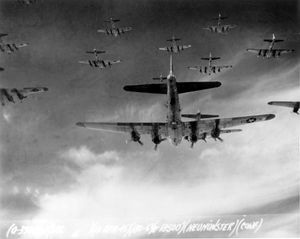
The B-17 was a versatile aircraft, serving in dozens of USAAF units in theaters of combat throughout World War II, and in non-bomber roles for the RAF. Its main use was in Europe, where its shorter range and smaller bombload relative to other aircraft available did not hamper it as much as in the Pacific Theater. Peak USAAF inventory (in August, 1944) was 4,574 worldwide.[47]
During World War II, after crash-landing or being forced down, approximately 40 B-17s were repaired and put back into the air by the Luftwaffe. These captured aircraft were codenamed "Dornier Do 200", given German markings and used for clandestine spy and reconnaissance missions by the Luftwaffe-most often used by the Luftwaffe unit known as KG 200, hence a likely possibility as a source for the "Do 200" codename.[57]
Late in World War II, RAF and USAAF bombers that had been damaged in raids over the Reich would put down in Soviet-controlled territory rather than try to make it back to Western bases, and in April 1945 the Soviet Air Force issued a directive to its units in the field to report the location of any aircraft of its Western Allies that were in Soviet hands; among the aircraft salvaged were a total of 73 B-17s. The Fortresses that were in the best condition were returned to the USAAF, but a number were retained as interim heavy bombers. Although Russian aircrews and maintenance crews had no experience with such aircraft, the Soviets proved ingenious at keeping them flying, and in fact were delighted with the B-17's handling, comparing it to a "swallow" and the nimble Po-2 biplane trainer. On the other hand, Soviet officials tended to order the "filthy pictures" applied to the aircraft removed or painted out. The B-17s remained in service until 1948, when the Tupolev Tu-4 began to arrive at operational squadrons.[58]
When Israel achieved statehood in 1948, the Israeli Air Force had to be assembled quickly to defend the new nation from the war it found itself almost immediately embroiled in. Among the first aircraft acquired by the Israeli Air Force were three surplus American B-17s, smuggled via South America and Czechoslovakia to avoid an arms trading ban imposed by the United States. A fourth plane was abandoned due to malfunctions and confiscated by American officials. On their delivery flight from Europe, in retaliation for Egyptian bombing raids on Tel-Aviv, the aircraft were ordered to bomb King Farouk's Royal Palace in Cairo before continuing to Israel. They performed the mission (despite some of the crew fainting due to defective oxygen equipment), but caused little damage. The B-17s were generally unsuitable for the needs of the Israeli Air Force, and the nature of the conflict in which long-range bombing raids on large area targets were relatively unimportant—although the psychological impact of the raids was not lost on the enemy. The aircraft were mainly used in the 1948 Arab-Israeli War, flown by 69 Squadron IAF; they were withdrawn in 1958 after seeing minor action in the 1956 Suez Crisis.[60][61]
Other countries acquired and operated B-17s:
- Template:BOL — Used 26 B-17s in civil aviation under different operators.[59]
- Template:BRA — Acquired 13 B-17s in 1951, according to the Rio Pact of 1947. They were used by the 1º and 2º Esquadrões (1st and 2nd Squadrons) of 6º Grupo de Aviação (6th Aviation Group), based at Recife, for search and rescue and photo-reconnaissance until 1968.[62]
- Template:CAN — The RCAF's six Flying Fortresses (three B-17Es and three B-17Fs) flew 240 trans-Atlantic mail flights from Canada to Canadian troops serving in Europe from 6 December 1943 to 27 December 1946. All six belonged to no. 168 Heavy Transport Squadron which operated out of RCAF Station Rockcliffe, Ontario.[63]
- Template:COL
- Template:DNK — Danish airline DDL bought two B-17s from Sweden in 1945.[59] One of these planes was transferred to the Danish Army Air Corps in 1948. In 1949, it was transferred to the Royal Danish Navy and in 1952 to the Royal Danish Air Force.
- Template:DOM — Acquired two B-17Gs in 1947.[62]
- Template:FRA — Used one B-17F as an executive transport for Free-French General M. P. Koening.[62]
 Japan — At least three early versions B-17s (2 B-17Ds and early B-17E) were captured by the Japanese in the Philippines and Netherlands East Indies. Planes were tested by the IJAAF Koku Gijutsu Kenkyujo (Air Technical Research Laboratory) at Tachikawa.
Japan — At least three early versions B-17s (2 B-17Ds and early B-17E) were captured by the Japanese in the Philippines and Netherlands East Indies. Planes were tested by the IJAAF Koku Gijutsu Kenkyujo (Air Technical Research Laboratory) at Tachikawa.- Template:NIC
- Template:PER
- Template:POR — Força Aérea Portuguesa (Portuguese Air Force) operated five SB-17Gs as search-and-rescue planes from 1957 to 1960.[62]
- Template:SWE — Purchased nine interned Fortresses for $1.00
- Template:USA — Following the war, Trans World Airlines purchased a surplus B-17G and used it to survey and set up routes in the Middle-East. In 1947, it was given to the Shah of Iran.[59]
Variants/design stages
| Variant | Produced | Total | First flight |
|---|---|---|---|
| Model 299 | 1 | 1 | 28 July 1935[1] |
| YB-17 | 13 | 13 | 2 December 1936[64] |
| YB-17A | 1 | 1 | 29 April 1938.[26] |
| B-17B | 39 | 39 | 27 June 1939[39] |
| B-17C | 38 | 38 | 21 July 1940[65] |
| B-17D | 42 | 42 | 3 February 1941[66] |
| B-17E | 512 | 512 | 5 September 1941[67] |
| B-17F | 3,405 | 3,405 | 30 May 1942[68] |
| B-17F-BO | 2,300 | ||
| B-17F-DL | 605 | ||
| B-17F-VE | 500 | ||
| B-17G | 8,680 | 8,680 | |
| B-17G-BO | 4,035 | ||
| B-17G-DL | 2,395 | ||
| B-17G-VE | 2,250 | ||
| Grand total | 12,731 |
The B-17 went through several alterations in each of its design stages and variants. Of the 13 YB-17s ordered for service testing, 12 were used by the 2nd Bomb Group of Langley Field, Virginia to develop heavy bombing techniques, and the 13th was used for flight testing at the Material Division at Wright Field, Ohio.[25] Experiments on this plane led to the use of a turbo-supercharger, which would become standard on the B-17 line. A 14th plane, the Y1B-17A, originally destined for ground testing only, was upgraded with the turbocharger. When this aircraft had finished testing, it was re-designated the B-17A, and in April 1938 was the first plane to enter service under the B-17 designation.[25][27]
As the production line developed, Boeing engineers continued to improve upon the basic design. To enhance performance at slower speeds, the B-17B was altered to include larger rudder and flaps.[39] The B-17C changed from gun blisters to flush, oval-shaped windows.[65] Most significantly, with the B-17E version, the fuselage was extended by 10 feet, a much larger vertical fin and rudder were incorporated into the original design, a gunner's position in the tail and an improved nose were added. The engines were upgraded to more powerful versions several times, and similarly, the gun stations were altered on numerous occasions to enhance their effectiveness.[67]
By the time the definitive B-17G appeared, the number of guns had been increased from seven to 13, the designs of the gun stations were finalized, and other adjustments were complete. The B-17G was the final version of the B-17, incorporating all changes made to its predecessor, the B-17F, and in total 8,680 were built, the last one on 9 April 1945.[69] Many B-17Gs were converted for other missions such as cargo hauling, engine testing and reconnaissance.[70] Initially designated SB-17G, a number of B-17Gs were also converted for search-and-rescue duties, later to be redesignated B-17H.[71]
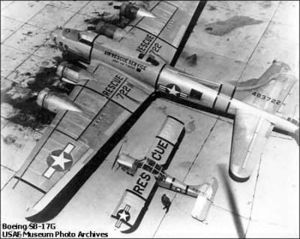
Two versions of the B-17 were flown under different designations. These were the XB-38 and the YB-40. The XB-38 was an engine test-bed for Allison V-1710 liquid-cooled engines, should the Wright engines normally used on the B-17 become unavailable. The YB-40 was a heavily armed modification of the standard B-17 used before the P-51 Mustang, an effective long-range fighter, became available to act as escort. Additional armament included a power turret in the radio-room, a chin turret (which went on to become standard with the B-17G) and twin .50 caliber (12.7 mm) guns in the waist positions. The ammunition load was over 11,000 rounds, making the YB-40 well over 10,000 pounds (4,500 kg) heavier than a fully loaded B-17F. Unfortunately, the YB-40s with their numerous heavy modifications had trouble keeping up with empty bombers, and so, together with the advent of the P-51 Mustang, the project was abandoned and finally phased out in July 1943.[72][73]
Late in World War II, at least 25 B-17s were fitted with radio controls, loaded with 20,000 pounds (9,000 kg) of high-explosives, dubbed "BQ-7 Aphrodite missiles", and used against U-boat pens and bomb-resistant fortifications. Because few (if any) BQ-7s hit their target, the Aphrodite project was scrapped in early 1945.[74][75] During and after World War II, a number of weapons were tested and used operationally on B-17s. Some of these weapons included "razons" (radio-guided) glide bombs, and Ford-Republic JB-2 Loons, also nicknamed Thunderbugs— American reverse-engineered models of the German V-1 Buzz Bomb. A much-used travelling airborne shot of a V-1/JB-2 launch in World War II documentaries was filmed from a USAF A-26 of the Air Proving Grounds, Eglin Air Force Base, launched from Santa Rosa Island, Florida. In the late 1950s, the last B-17s in United States Air Force service were QB-17 drones and DB-17P drone controllers, plus a few polished VB-17 squadron "hacks". The last operational mission flown by a USAF Fortress was conducted on 6 August 1959, when DB-17P 44-83684 directed QB-17G 44-83717 out of Holloman Air Force Base as a target for a Falcon air-to-air missile fired from an F-101 Voodoo fighter. A retirement ceremony was held several days later at Holloman, after which 44-83684 was retired to MASDC at Davis-Monthan Air Force Base.
The Fortress as a symbol
The B-17 Flying Fortress has become, for many reasons, deserved or not, an icon of American power and a symbol of its Air Force. It achieved a lasting fame in the general public, which has eluded most other bomber aircraft.[9]
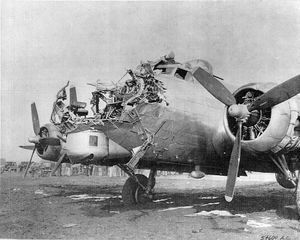
During the 1930s, the USAAC, under Gen. Frank Maxwell Andrews and the Air Corps Tactical School, touted the bomber as a strategic weapon.[76] Gen Henry H. Arnold, Chief of the Air Corps, recommended the devolpment of bigger airplanes with better performance and the Tactical school agreed completely.[77] The B-17 was exactly what the Air Corps was looking for; it was a high-flying, long-ranging potent bomber capable of defending itself.
When the Model 299 was rolled out on 28 July 1935, bristling with multiple machine gun installations, Richard Williams, a reporter for the Seattle Times coined the name "Flying Fortress" with his comment "Why, it's a flying fortress!".[10] Boeing was quick to see the value of the name and had it trademarked for use.
After the initial B-17s were delivered to the Air Corps 2nd Bombardment Group, they began sending them on promotional flights emphasizing its great range and navigational precision. In early 1938, Group commander Colonel Robert C. Olds flew a Y1B-17 from the east to west coast. Setting a transcontinental record of 12 hours 50 minutes. He also broke the west-to-east coast record on the return trip, averaging 245 mph in ten hours 46 minutes. Six planes of the 2nd Bombardment group took off from Langley AFB on 15 February 1938 as part of a good will flight to Buenos Aires, Argentina. Covering 12,000 miles they returned on 27 February.[64] In a well publicized mission, three B-17s, "intercepted" and took photographs of the Italian ocean liner Rex 800 miles off the Atlantic coast.[24]
The Flying Fortress found a place in the public psyche as well. In 1943, Consolidated Aircraft commissioned a poll to see “to what degree the public is familiar with the names of the Liberator and the Flying Fortress.” Of 2,500 men in cities where Consolidated ads had been run in newspapers, only 73 percent had heard of the Liberator, while 90 percent knew of the B-17.[9]
Hollywood featured the airplane in its movies, such as Twelve O'Clock High, with Gregory Peck.[78] This film was made with the full cooperation of the United States Air Force and made use of actual combat footage. In 1964 the movie was made into a television show of the same name, and ran for three years. The B-17 also appeared in the 1938 movie Test Pilot with Clark Gable and Spencer Tracy.
During the war, the largest offensive bombing force, the Eighth Air Force, was run by officers who openly preferred the B-17. Lt. Gen. Jimmy Doolittle wrote about his preference for equipping the Eighth with B-17s. Citing the logistical advantage in keeping fielded forces down to a minimum number of aircraft types with their unique servicing and spares, he wanted B-17 bombers and P-51 fighters for the Eighth. His views were supported by Eighth Air Force statisticians, whose studies purportedly showed that Fortresses had utility and survivability much greater than that of the B-24.[9]
Loved by its crews for bringing them home despite extensive battle damage, its durability, especially in belly-landings and ditchings, quickly took on mythical proportions.[79][80][8] Stories and photos of B-17s surviving battle damage widely circulated, boosting its iconic status.[9] Despite an inferior performance and bombload compared to the more numerous B-24 Liberator,[10] a survey of Eighth Air Force crews showed a much higher rate of satisfaction in the B-17.[11]
The most famous B-17, the Memphis Belle, toured the U.S. with its crew to reinforce national morale (and to sell War Bonds), and starred in a USAAF documentary, Memphis Belle: A Story of a Flying Fortress.[81]
After the war ended, most B-17s were scrapped, but the U.S. Air Force did keep some B-17s for VIP transports and drone directors. The Navy and Coast Guard obtained thirty B-17s, beginning in 1945, for over-water patrols as PB-1Gs as air rescue aircraft, similar to USAF B-17Hs, and PB-1Ws, patrol craft with early warning radar installations aboard. The war ended before any PB-1Ws were operational and defensive armament was subsequently deleted. The Coast Guard retired PB-1G BuNo 77254, in October 1959, the last U.S. military Fortress in operation.
Throughout the 1960s and 1970s, the surviving Fortresses had to earn their keep, as operation of a four-engine aircraft was costly, and the Warbirds preservation movement had not yet begun. The preservation of the remaining Fortresses gained steam when firebomber B-17s began to come on the market in the 1970s.
Noted B-17s
Memphis Belle
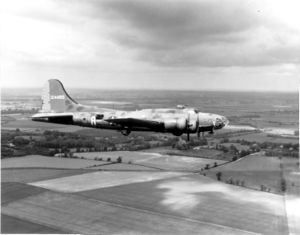
The Memphis Belle, B-17F-10-BO, 41-24485, which flew 25 missions over Europe before touring the United States to advertise war bonds, is arguably the most famous B-17 to survive.[82] Forgotten in the post-war rush to disarm, the "Belle" was rescued off a salvage yard at Altus, Oklahoma in 1946 by an alert Memphis citizen who convinced the city fathers to reclaim the bomber before it was scrapped. The "Belle" was displayed at several locations in Memphis from 1948 to 2003, and was then transported to Wright-Patterson Air Force Base in October 2005 for restoration and eventual display at the National Museum of the United States Air Force. The restoration is expected to take eight to ten years.[83]
Memphis Belle should be not be confused with the former firebomber E-78, B-17G-85-DL, 44-83546, civil register N3703G, which was back-dated in appearance by removal of the chin turret for its role as the Memphis Belle in the 1990 film Memphis Belle, and continues to be shown at airshows in that guise, flown by the Military Aircraft Restoration Corporation, American Airpower Museum, Farmingdale, New York.
The Swoose
The Swoose, B-17D-BO, 40-3097, the only surviving example of the shark fin B-17s of the A, B, C and D series, flew combat missions in the Pacific Theater before being converted to an unarmed transport/flying command-post used in Australia by Lt. Gen. George Brett, commander of Allied air forces in the South West Pacific Area. It returned to the United States with Brett in 1943, and is the oldest surviving B-17 in the world. "The Swoose" is presently in storage at the Smithsonian Institution's Silver Hill ("Paul E. Garber" Preservation, Restoration and Storage Facility in Suitland, Maryland) where, as of 2000, no plans have yet been made to restore her.[84] Col. Frank Kurtz, commanding officer of the 463rd Bombardment Group at the Celone Airbase near Foggia, Italy, and the father of actress Swoosie Kurtz (b. 1944), carried the Swoose name forward from the original Swoose (which he flew in the Pacific prior to being named CO of the 463rd), naming the B-17G he flew with the 463rd "Swoose II".[85] The 463rd BG was thereafter known as the "The Swoose Group". The name "Swoosie" was a derivative of Kurtz's Pacific aircraft, so-named by 19th Bomb Group pilot Captain Weldon Smith, after the tail of 40-3091 was grafted onto 40-3097, resulting in an aircraft that was "half-swan, half-goose", from bandleader Kay Kyser's song, Alexander the Swoose.[86]
Shoo Shoo Baby
Shoo Shoo Baby (later called Shoo Shoo Shoo Baby), B-17G-35-BO, 42-32076, 401st BS, marked LL-E, flew 24 combat missions from England with the 91st Bomb Group from March 1944 until being forced to crash-land at Malmö Airport, Sweden. Being neutral, Sweden interned the crew, and about the same time a deal was made between the Swedish and U.S. governments to allow around 300 American crewmen to return in exchange for nine B-17Fs and B-17Gs that had landed intact in Sweden. Seven of these were converted by Saab Aircraft into airliners that could carry 14 passengers.[87] Repaired in Sweden, it had been used as a civilian transport and recovered in 1972, where it was dismantled, taken to Dover Air Force Base, Delaware, for restoration, and turned over to National Museum of the United States Air Force in Dayton, Ohio on October 13 1988, where it is on display. Due to the amount of skin work required to restore its wartime appearance, it is finished in olive drab and grey, instead of bare-metal as it was during its USAAF service.
Nine-O-Nine
The Nine-O-Nine, a B-17G-30-BO, 42-31909, of the 91st Bomb Group, 323rd Bomb Squadron, completed 140 missions without an abort or loss of a crewman, an 8th Air Force record. Assigned to combat on 25 February 1944 she made 18 trips to Berlin, dropped 562,000 pounds of bombs, and flew 1,129 hours. She had 21 engine changes, four wing panel changes, 15 main gas tank changes, and 18 Tokyo tank changes (long-range fuel tanks). M/Sgt. Rollin L. Davis, a maintenance line chief in charge of this plane, received the Bronze Star for his part in this.[88] She wound up at the RFC facility at Kingman, Arizona on 7 December 1945, and was scrapped. The Collings Foundation, Stow, Massachusetts, B-17G-85-DL, 44-83575, civil register N93102, currently appears at airshows marked as the historic Nine-O-Nine.
My Gal Sal
On 27 June 1942 B-17E-BO, 41-9032, named My Gal Sal, and another B-17 were navigating and acting as mother ships along with six P-38 Lightnings on a ferry flight to the United Kingdom as part of Operation Bolero, the military build-up in Europe, but were forced to land on a glacier in Greenland because of bad weather. None of the crew were lost, but the aircraft were not recovered from the Glacier until 1995. One of the P-38s was recovered and restored as Glacier Girl, and the B-17 My Gal Sal has been recovered and is being restored to a static configuration in Cincinnati.[89][90][91]
Surviving B-17s
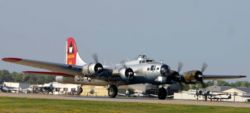
Altogether 44 B-17 have survived and, as of January 2007, 14 still fly. Examples include:[92]
- Aluminum Overcast (44-85740) — The Experimental Aircraft Association's B-17G that tours the U.S. offering flight experiences.[93]
- Liberty Belle (44-85734) — The Liberty Foundation’s B-17G[94]
- Picadilly Lilly II (44-83684) — The last active B-17 in the United States Air Force, retired in 1959 after nine years as a DB-17P drone director. Acquired by Edward G. Maloney for his infant air museum, first at Claremont, California, then at Ontario Airport, California through 1969. Primary aircraft for Twelve O' Clock High television series, 1964-1966 as Picadilly Lily (one "l"). Now at the museum Planes of Fame, Chino, California.[84]
- The Pink Lady (44-8846) — Flew 6 missions in April 1945 for the 351st Bomber Group of the 511th Bomber Squadron. Purchased by the French National Geographic Institute for survey work. Restored in 1984, it flew in the US film Memphis Belle as Mother and Country.[95]
- Return to Glory, formally Starduster II (44-6393) — The B-17G was delivered to the 97th Bomb Group of the 15th Air Force August 1944, was modified to a VB-17 and assigned to General Ira C. Eaker until he retired. Sold to Bolivia, it flew cargo until reacquired by the USAF Museum. It has been restored to its wartime appearance at the March Field Air Museum, March Air Reserve Base, Riverside, California.[96]
- Sally B (44-85784) — Housed at the Imperial War Museum Duxford, England.[97]
- Sentimental Journey (44-83514) — Housed at the museum at Falcon Field, Arizona by the Commemorative Air Force.[84]
- Thunderbird (44-85718) — Housed at the Lone Star Flight Museum, Galveston, Texas.[84]
- Wicked Wanda/Gremlin's Hideout/now unnamed (44-83863) — B-17G-95-DL/PB-1W BuNo 77231/firebomber, Tanker 18/71/D1, N5233V, now on display at Air Force Armament Museum, Eglin Air Force Base, Florida.[98]
Noted B-17 pilots and crew members
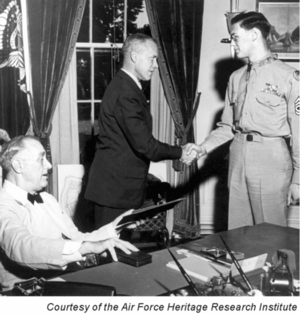
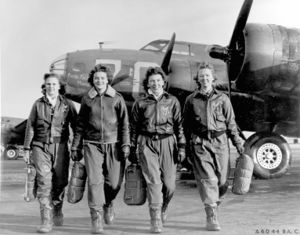
Military decorations
Many B-17 crew members received military honors and 17 received the Medal of Honor, the highest military decoration awarded by the United States:[31]
- Brig. Gen. Frederick Castle[99]
- 2d Lt. Robert Femoyer[100]
- 1st Lt. Donald Gott[101]
- 2d Lt. David Kingsley[102]
- 1st Lt. William R. Lawley, Jr.[103]
- Sgt. Archibald Mathies (awarded posthumously)[104]
- Lt. Jack Mathis (the first airman in the European theater to win a Medal of Honor)[105]
- 2d Lt. William Metzger[101]
- Lt. Edward Michael[106]
- 1st Lt. John C. Morgan[107]
- Capt. Harl Pease[108]
- 2nd Lt. Joseph Sarnoski (awarded posthumously)[109]
- Sgt. Maynard H. Smith (the first enlisted airman ever to win a Medal of Honor)[110]
- Lt. Walter E. Truemper (awarded posthumously)[104]
- SSgt. Forrest L. Vosler[111]
- Brig. Gen. Kenneth Walker[112]
- Maj. Jay Zeamer, Jr.[113]
Other military achievements or events
- Allison C. Brooks (1917–2006) — Was awarded numerous military decorations, and was ultimately promoted to the rank of major general (two stars) and served in active duty until 1971.
- Capt. Werner G. Goering — American-born nephew of the Nazi Commander of the Luftwaffe in World War II, Hermann Goering.[114]
- Immanuel J. Klette — Second-generation German-American whose 91 combat missions were the most flown by any Eighth Air Force pilot in World War II.[115]
- Colin Kelly (1915–1941) — Pilot of the first U.S. B-17 lost in action.[116]
- Col. Frank Kurtz (1911–1996) — The USAAF's most decorated pilot of World War II; Commander of the 463rd Bombardment Group (Heavy), 15th Air Force, Celone Field, Foggia, Italy; Clark Field Philippines attack survivor; Olympic bronze medalist in diving (1932), 1944–1945; father of actress Swoosie Kurtz.
- Gen. Curtis LeMay (1906–1990) — Became head of the Strategic Air Command and head of the USAF.
- Col. Robert K. Morgan (1918–2004) — Pilot of Memphis Belle.
- Paul Tibbets (b. 1915) — Flew with the 97th Bombardment Group (Heavy) with both the 8th Air Force in England and the 12th Air Force in North Africa; later pilot of the B-29 Enola Gay dropping the atomic bomb on Hiroshima, Japan.
- Robert Webb — One of the youngest bomber pilots in the US Army Air Forces.
Civilian achievements or events
- Martin Caidin — Author of Cyborg, the story that formed the basis of The Six Million Dollar Man and the saga of the last transatlantic formation flight of B-17s ever made, Everything But the Flak.
- Clark Gable (1901–1960) — Academy Award-winning film actor, formally waist gunner on B-17 Eight Ball of the 359th Bomb Squadron.
- Tom Landry — American football player and coach, flew 30 missions over Europe as a B-17 pilot, surviving a crash landing in Czechoslovakia. (His older brother Robert died in a B-17 crash) [117]
- Norman Lear — Radio operator, with the 463rd Bombardment Group (Heavy), 15th Air Force, Celone Field, Foggia, Italy; television producer of American sitcoms Sanford and Son, Maude and All in the Family, among others.
- Gene Roddenberry — Creator of Star Trek; flew B-17s for the 394th Bomb Squadron (H), in the Pacific theater.[118]
- Robert Rosenthal — Assistant to the U.S. prosecutor at the Nuremberg Trials, where he interrogated Hermann Goering.
- Brigadier General Robert Lee Scott, Jr. (1908–2006) — Best known for his autobiography God is My Co-Pilot, which has been made into a film of the same, about his exploits in World War II with the Flying Tigers and the United States Army Air Forces in China and Burma.
- Jimmy Stewart — American film actor, instructed in B-17s before flying combat in B-24s with the 8th Air Force, England; retired from Air Force Reserve a Brigadier General.[119]
- Bert Stiles (1920-1944) — Short-story author, killed in World War II airplane crash.
- Smokey Yunick — Award-winning motorsports car designer and premier NASCAR crew chief.
Specifications (B-17G)
Data from The Encyclopedia of World Aircraft[26]
General characteristics
- Crew: 10: Pilot, co-pilot, navigator, bombardier/nose gunner, flight engineer-top turret gunner, radio operator, waist gunners (2), ball turret gunner, tail gunner[120]
- Length: 74 ft 4 in (22.66 m)
- Wingspan: 103 ft 9 in (31.62 m)
- Height: 19 ft 1 in (5.82 m)
- Wing area: 1,420 ft² (131.92 m²)
- Airfoil: NACA 0018 / NACA 0010
- Empty weight: 36,135 lb (16,391 kg)
- Loaded weight: 54,000 lb (24,495 kg)
- Max takeoff weight: 65,500 lb (29710 kg)
- Powerplant: 4× Wright R-1820-97 "Cyclone" turbosupercharged radial engines, 1,200 hp (895 kW) each
Performance
- Maximum speed: 287 mph (249 knots, 462 km/h)
- Cruise speed: 182 mph (158 knots, 293 km/h)
- Range: 1,738 nm (2,000 mi, 3,219 km) with 2,722 kg (6,000 lb) bombload
- Service ceiling: 35,600 ft (10,850 m)
- Rate of climb: 900 ft/min (4.6 m/s)
- Wing loading: 38.0 lb/ft² (185.7 kg/m²)
- Power/mass: 0.089 hp/lb (150 W/kg)
Armament
- Guns: 13× M2 Browning 0.50 caliber (12.7 mm) machine guns (with optional extra nose armament fitted in glazed nose)
- Bombs: 17,600 lbs (maximum)
- Short range missions (<400 mi): 8,000 lb (3,600 kg)
- Long range missions (≈800 mi): 4,500 lb (2,000 kg)
- See also: Maximum reported B-17 & B-24 bomb loads
References
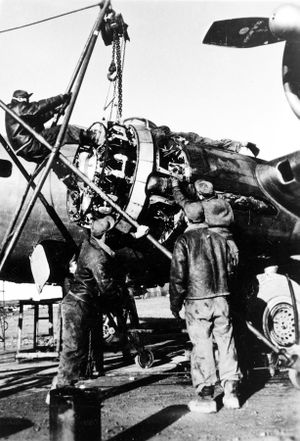
- ↑ 1.0 1.1 1.2 The Boeing Logbook: 1933 – 1938. Boeing.com. Retrieved on 18 December 2006.
- ↑ [1]
- ↑ Yenne, Bill. B-17 at War. St Paul, Minnesota: Zenith Imprint, 2006.ISBN 0-7603-2522-7. p. 8.
- ↑ Bowers, Peter M. (1976). Fortress in the Sky. Granada Hills, California: Sentry Books Inc.. ISBN 0-913194-04-2.
- ↑ 5.0 5.1 5.2 Carey, Brian Todd (1998). "Operation Pointblank: Evolution of Allied Air Doctrine During World War II". World War II (November): p. 4 Retrieved on 15 January 2007.
- ↑ "The Story of the B-17", B-17 Pilot Training Manual. Headquarters, AAF, Office of Flying Safety. Retrieved on 16 January. “The B-17's incredible capacity to take it — to come flying home on three, two, even one engine, sieve-like with flak and bullet holes, with large sections of wing or tail surfaces shot away — has been so widely publicized that U. S. fighting men could afford to joke about it" and "one important fact stands clear-cut now. The Flying Fortress is a rugged airplane”
- ↑ Browne, Robert W. (Winter 2001). "The Rugged Fortress: Life-Saving B-17 Remembered". Flight Journal: WW II Bombers (Winter 2001) Retrieved on 18 December 2006.
- ↑ 8.0 8.1 B-17 Flying Fortress. www.b17fortress.de (2006). Retrieved on 17 January 2007. “General Ira C. Eaker, commander of the Eighth Air Force during World War II described the plane as "the best bomber which was ever built. She could handle extensive damage and still stay in the air."”
- ↑ 9.0 9.1 9.2 9.3 9.4 Johnson, Frederick A. (2006). "The Making of an Iconic Bomber". Air Force Magazine 89 (10) Retrieved on 15 January 2007. Cite error: Invalid
<ref>tag; name "Johnson 2006" defined multiple times with different content - ↑ 10.0 10.1 10.2 10.3 Baugher, Joe. Boeing Model 299. Encyclopedia of American Aircraft. Retrieved on 12 January, 2007.
- ↑ 11.0 11.1 B-17:Best Airplane. B-17 Flying Fortress:Queen of the Skies. Retrieved on 9 January, 2007.
- ↑ 12.0 12.1 12.2 12.3 12.4 12.5 Aviation Photography:B-17 Flying Fortress. Northstar Gallery. Retrieved on 16 January, 2007.
- ↑ 13.0 13.1 13.2 13.3 13.4 Goebel, Greg (2005). Fortress In Development: Model 299. The Boeing B-17 Flying Fortress. Retrieved on 9 January, 2007.
- ↑ Tate, Dr. James P. (June 1998). 1-42891-257-6&id=pZyLTfJFaEgC&dq=The+Army+and+Its+Air+Corps+Army+Policy+toward+Aviation The Army and Its Air Corps: Army Policy toward Aviation 1919–1941. Maxwell Air Force Base, Alabama: Air University Press, p. 164. ISBN 1428912576. Retrieved on 16 January.
- ↑ Salecker, Gene, Eric (2001). Fortress Against the Sun: The B-17 Flying Fortress in the Pacific. Conshohocken, Pennsylvania: Combined Publishing, p. 46. ISBN 1-58097-049-4.
- ↑ Yenne, Bill (2006). B-17 at War. St Paul, Minnesota: Zenith Imprint, p. 12. ISBN 0-7603-2522-7.
- ↑ 17.0 17.1 Tate, Dr. James P. (June 1998). The Army and Its Air Corps: Army Policy toward Aviation 1919–1941. Maxwell Air Force Base, Alabama: Air University Press, p. 165. ISBN 1428912576. Retrieved on 16 January.
- ↑ Model 299 Crash, 15 November 1935. National Museum of the USAF. Retrieved on 16 January, 2007.
- ↑ Schamel, John. How the Pilot's Checklist Came About. FAA Flight Service Training. Retrieved on 12 January 2007. “On board the plane were pilots Major Ployer P. Hill (his first time flying the 299) and Lieutenant Donald Putt (the primary Army pilot for the previous evaluation flights), Leslie Tower, Boeing mechanic C.W. Benton, and Pratt and Whitney representative Henry Igo. Putt, Benton and Igo escaped with burns, and Hill and Tower were pulled from the wreckage alive, but later died from their wounds.”
- ↑ Salecker, Gene Eric (2001). Fortress Against the Sun: The B-17 Flying Fortress in the Pacific. Conshohocken, Pennsylvania: Combined Publishing, p. 48. ISBN 1-58097-049-4.
- ↑ Goebel, Greg (2005). Model 299 Flying Fortress. The Boeing B-17 Flying Fortress. Retrieved on 9 January, 2007. “The Model 299 cost almost $200,000, more than twice as much as either of its two competitors.”
- ↑ 22.0 22.1 22.2 Meilinger, Phillip S. (October 2004). "When the Fortress Went Down". Air Force Magazine 87 (9) Retrieved on 16 January 2007.
- ↑ Schamel, John. How the Pilot's Checklist Came About. FAA Flight Service Training. Retrieved on 12 January, 2007. “The idea of a pilot's checklist spread to other crew members, other Air Corps aircraft types, and eventually throughout the aviation world.”
- ↑ 24.0 24.1 Intercepting The “Rex”. National Museum of the USAF. Retrieved on 9 January, 2007.
- ↑ 25.0 25.1 25.2 BOEING Y1B-17. National Museum of the USAF. Retrieved on 9 January, 2007.
- ↑ 26.0 26.1 26.2 "Boeing Model 299 (B-17 Flying Fortress)". The Encyclopedia of World Aircraft (1): p. 155. (1997). Ed. David Donald. Etobicoke, Ontario, Canada: Prospero Books.
- ↑ 27.0 27.1 27.2 Goebel, Greg (2005). Y1B-17/Y1B-17A. The Boeing B-17 Flying Fortress. Retrieved on 9 January, 2007.
- ↑ Baugher, Joe. Boeing Y1B-17A/B-17A. Encyclopedia of American Aircraft. Retrieved on 15 January, 2007.
- ↑ 29.0 29.1 Goebel, Greg (2005). B-17B/B-17C/B-17D. The Boeing B-17 Flying Fortress. Retrieved on 9 January, 2007.
- ↑ Boeing B-17B. National Museum of the USAF. Retrieved on 9 January, 2007.
- ↑ 31.0 31.1 Eylanbekov, Zaur (2006). Airpower Classics:B-17 Flying Fortress. Air Force Magazine. Retrieved on 8 January, 2007.
- ↑ Serling, Robert J. (1992). Legend & Legacy: The Story of Boeing and its People. New York: St. Martin's Press, p. 55. ISBN 0-312-05890-X. “At the peak of production, Boeing was rolling out as many as 363 B-17s a month—averaging between 14 and 16 Forts a day, the most incredible production rate for large aircraft in aviation history…Prior to the B-17, the Boeing Y1B-9 (first flight: 1931) had only seven production aircraft, the Martin B-10 (first flight: 1932) had total production of 213, the Farman F.222 (first flight: 1932) had only 24 constructed and the Handley Page Heyford (first flight: 1933) had a total of 125 built. The B-17 easily eclipsed these numbers.”
- ↑ Yenne, Bill (2006). B-17 at War. St Paul, Minnesota: Zenith Imprint, p. 6. ISBN 0-7603-2522-7.
- ↑ Carey, Brian Todd (1998). "Operation Pointblank: Evolution of Allied Air Doctrine During World War II". World War II (November): p. 4 Retrieved on 15 January 2007.
- ↑ Yenne, Bill (2006). B-17 at War. St Paul, Minnesota: Zenith Imprint, p. 23. ISBN 0-7603-2522-7.
- ↑ Chant, Christopher (1996). Warplanes of the 20th Century. London: Tiger Books International, p. 61–62. ISBN 1-85501-807-1.
- ↑ 37.0 37.1 Goebel, Greg (2005). RAF Fortress I In Combat. The Boeing B-17 Flying Fortress. Retrieved on 9 January, 2007.
- ↑ 38.0 38.1 Baugher, Joe. Fortress I for RAF. Encyclopedia of American Aircraft. Retrieved on 15 January, 2007.
- ↑ 39.0 39.1 39.2 Baugher, Joe. Boeing B-17B Fortress. Encyclopedia of American Aircraft. Retrieved on 15 January, 2007.
- ↑ Boeing B-17 Flying Fortress – USA. The Aviation History Online Museum. Retrieved on 16 January, 2007.
- ↑ 41.0 41.1 Goebel, Greg (2005). Fortress Over Europe. The Boeing B-17 Flying Fortress. Retrieved on 9 January, 2007.
- ↑ Walden, Geoff (January 2007). Third Reich in Ruins:Schweinfurt. www.thirdreichruins.com. Retrieved on 16 January, 2007.
- ↑ McKillop, Jack. Combat Chronology of the US Army Air Forces: February 1944. www.usaaf.net. Retrieved on 17 January, 2007.
- ↑ Trueman, Chris. B-17 Flying Fortress. www.historylearningsite.co.uk. Retrieved on 16 January, 2007.
- ↑ McKillop, Jack. Combat Chronology of the US Army Air Forces: April 1945. www.usaaf.net. Retrieved on 17 January, 2007.
- ↑ Frisbee, John L. (December 1990). "Valor:Skip-Bombing Pioneer". Air Force Magazine 73 (12) Retrieved on 9 January 2007.
- ↑ 47.0 47.1 Baugher, Joe. B-17 Squadron Assignments. Encyclopedia of American Aircraft. Retrieved on 15 January, 2007.
- ↑ History:B-17 Flying Fortress. Boeing.com. Retrieved on 16 January, 2007.
- ↑ Formation. www.b17flyingfortress.de. Retrieved on 9 January, 2007.
- ↑ "Formation", B-17 Pilot Training Manual. Headquarters, AAF, Office of Flying Safety. Retrieved on 16 January.
- ↑ Caidin, Martin (1960). Black Thursday. New York: E.P. Dutton & Co. Inc.. ISBN 0-553-26729-9.
- ↑ Hoffman, Wally (2006). We Get Our Feet Wet. Magweb.com. Retrieved on 18 July, 2006.
- ↑ Caidin, Martin. Black Thursday. New York: E.P. Dutton & Co. Inc., 1960. ISBN 0-553-26729-9. p.86.
- ↑ Battle-damaged B-17s. www.daveswarbirds.com. Retrieved on 16 January, 2007.
- ↑ Price, Alfred (September 1993). "Against Regensburg and Schweinfurt". Air Force Magazine 76 (9) Retrieved on 10 January 2007.
- ↑ Schollars, Todd J. (Fall 2003). German wonder weapons: degraded production and effectiveness. Air Force Journal of Logistics. Retrieved on 16 January, 2007.
- ↑ 57.0 57.1 Law, Ricky (1997). Dornier Do 200. Arsenal of Dictatorship. Retrieved on 16 January, 2007.
- ↑ 58.0 58.1 Goebel, Greg (2005). Fortress Oddballs. The Boeing B-17 Flying Fortress. Retrieved on 9 January, 2007.
- ↑ 59.0 59.1 59.2 59.3 Baugher, Joe. B-17 Commercial Transports. Encyclopedia of American Aircraft. Retrieved on 15 January, 2007.
- ↑ Rozen, Owen. Israeli Air Force Bombers:Boeing B-17 Flying Fortress. The Israeli Air Force – IDF/AF. Retrieved on 24 December, 2006.
- ↑ Aloni, Shlomo (October 2006). "The Israeli View". Aeroplane 34 (10): p. 70–74 Retrieved on 7 February 2007.
- ↑ 62.0 62.1 62.2 62.3 Baugher, Joe. B-17 With Foreign Air Forces. Encyclopedia of American Aircraft. Retrieved on 15 January, 2007.
- ↑ Air Force Public Affairs/Department of National Defence (2004). Canada's Air Force:Boeing B-17 Flying Fortress. www.airforce.forces.gc.ca. Retrieved on 16 January, 2007.
- ↑ 64.0 64.1 Baugher, Joe. Boeing Y1B-17. Encyclopedia of American Aircraft. Retrieved on 15 January, 2007.
- ↑ 65.0 65.1 Baugher, Joe. Boeing B-17C Fortress. Encyclopedia of American Aircraft. Retrieved on 15 January, 2007.
- ↑ Baugher, Joe. Boeing B-17D Fortress. Encyclopedia of American Aircraft. Retrieved on 15 January, 2007.
- ↑ 67.0 67.1 Baugher, Joe. Boeing B-17E Fortress. Encyclopedia of American Aircraft. Retrieved on 15 January, 2007.
- ↑ Baugher, Joe. Boeing B-17F Fortress. Encyclopedia of American Aircraft. Retrieved on 15 January, 2007.
- ↑ Chronicle. www.b17flyingfortress.de. Retrieved on 16 January, 2007.
- ↑ Goebel, Greg (2005). B-17G/Fortress Triumphant. The Boeing B-17 Flying Fortress. Retrieved on 9 January, 2007.
- ↑ Baugher, Joe. Boeing B-17H. Encyclopedia of American Aircraft. Retrieved on 15 January, 2007.
- ↑ Baugher, Joe. Vega XB-38. Encyclopedia of American Aircraft. Retrieved on 15 January, 2007.
- ↑ Baugher, Joe. Boeing YB-40. Encyclopedia of American Aircraft. Retrieved on 15 January, 2007.
- ↑ Baugher, Joe. History of the BQ-7. Encyclopedia of American Aircraft. Retrieved on 15 January, 2007.
- ↑ Parsch, Andreas (March 2003). Boeing BQ-7 Aphrodite. Directory of U.S. Military Rockets and Missiles. Retrieved on 16 January, 2007.
- ↑ Tate, Dr. James P. (June 1998). 1-42891-257-6&id=pZyLTfJFaEgC&dq=The+Army+and+Its+Air+Corps+Army+Policy+toward+Aviation The Army and Its Air Corps: Army Policy toward Aviation 1919–1941. Maxwell Air Force Base, Alabama: Air University Press, p. 149–150. ISBN 1-42891-257-6. Retrieved on 16 January. “The Howell Commission's report…stated "…an adequate striking force for use against objectives both near and remote is a necessity for a modern army…”
- ↑ Tate, Dr. James P. (June 1998). 1-42891-257-6&id=pZyLTfJFaEgC&dq=The+Army+and+Its+Air+Corps+Army+Policy+toward+Aviation The Army and Its Air Corps: Army Policy toward Aviation 1919–1941. Maxwell Air Force Base, Alabama: Air University Press, p. 161. ISBN 1-42891-257-6. Retrieved on 16 January. “To them it seemed that the bomber was well-nigh invincible. They argued that pursuit was obsolete and attack an expensive luxury, since aviation was more effective when used for interdiction behind enemy lines and strategic bombardment to destroy the enemy's means and will to fight.”
- ↑ Twelve O'Clock High (1949). Internet Movie Database. Retrieved on 16 January, 2007.
- ↑ "The Story of the B-17", B-17 Pilot Training Manual. Headquarters, AAF, Office of Flying Safety. Retrieved on 16 January 2007. “The B-17's incredible capacity to take it — to come flying home on three, two, even one engine, sieve-like with flak and bullet holes, with large sections of wing or tail surfaces shot away — has been so widely publicized that U.S. fighting men could afford to joke about it" and "one important fact stands clear-cut now. The Flying Fortress is a rugged airplane”
- ↑ Browne, Robert W. (Winter 2001). "The Rugged Fortress: Life-Saving B-17 Remembered". Flight Journal: WW II Bombers (Winter 2001) Retrieved on 18 December 2006.
- ↑ The Memphis Belle: A Story of a Flying Fortress (1944). Internet Movie Database. Retrieved on 16 January, 2007.
- ↑ Memphisbelle.com. www.memphisbelle.com. Retrieved on 16 January, 2007.
- ↑ FAQ Memphis Belle. www.nationalmuseum.af.mil. Retrieved on 16 January, 2007.
- ↑ 84.0 84.1 84.2 84.3 B-17s: Where to find them. Aero Vintage Books. Retrieved on 15 January.
- ↑ The Swoose. 463rd Bombardment Group Historical Society. Retrieved on 18 December, 2006.
- ↑ Brennan, Sandra. Biography. All Movie Guide. Retrieved on 25 December, 2006.
- ↑ Boeing B-17G “Shoo Shoo Shoo Baby”. National Museum of the USAF. Retrieved on 9 January, 2007.
- ↑ History of the B-17 Nine O Nine. www.collingsfoundation.org (2001). Retrieved on 16 January, 2007.
- ↑ Hayes, David (November 1994). The Lost Squadron. Hyperion Books. ISBN 0-78686-048-0. Retrieved on 16 January.
- ↑ History Of The B-17E "My Gal Sal". www.ultimatesacrifice.com. Retrieved on 16 January, 2007.
- ↑ B-17E “MY GAL SAL”. National Museum of the USAF. Retrieved on 7 February, 2007.
- ↑ B-17:The History. www.b17flyingfortress.de. Retrieved on 11 January, 2007.
- ↑ The B-17 Aluminum Overcast. b17.org. Retrieved on 16 January 2007.
- ↑ Liberty Belle's history. Libertyfoundation.org (2007). Retrieved on 16 January, 2007.
- ↑ Ryan (September 2006). A Concise History of the Pink Lady. www.thepinklady.fr. Retrieved on 16 January, 2007.
- ↑ Boeing B-17G Flying Fortress. www.marchfield.org. Retrieved on 12 January 2007.
- ↑ Sally B:The History. sallyb.dcgservices.com/. Retrieved on 16 January 2007.
- ↑ Air Force Armaments Museum. www.destin-ation.com. Retrieved on 6 February 2007.
- ↑ Frisbee, John L. (March 1998). "Valor:The Quiet Hero". Air Force Magazine 71 (3) Retrieved on 16 January 2007.
- ↑ Frisbee, John L. (May 1985). "Valor:'I Am the Captain of My Soul'". Air Force Magazine 68 (5) Retrieved on 9 January 2007.
- ↑ 101.0 101.1 Frisbee, John L. (June 1989). "Valor:"Valor at its Highest"". Air Force Magazine 72 (6) Retrieved on 9 January 2007.
- ↑ Frisbee, John L. (August 1990). "Valor:A Rather Special Award". Air Force Magazine 73 (8) Retrieved on 9 January 2007.
- ↑ Frisbee, John L. (June 1999). "Valor:One Turning and One Burning". Air Force Magazine 82 (6) Retrieved on 9 January 2007.
- ↑ 104.0 104.1 Frisbee, John L. (August 1985). "Valor:A Point of Honor". Air Force Magazine 68 (8) Retrieved on 9 January 2007.
- ↑ Frisbee, John L. (March 1986). "Valor:A Tale of Two Texans". Air Force Magazine 69 (3) Retrieved on 9 January 2007.
- ↑ Frisbee, John L. (August 1985). "Valor:Gauntlet of Fire". Air Force Magazine 68 (8) Retrieved on 9 January 2007.
- ↑ Frisbee, John L. (January 1984). "Valor:Crisis in the Cockpit". Air Force Magazine 67 (1) Retrieved on 9 January 2007.
- ↑ Frisbee, John L. (July 1990). "Valor:Rabaul on a Wing and a Prayer". Air Force Magazine 73 (7) Retrieved on 9 January 2007.
- ↑ MOH citation of SARNOSKI, JOSEPH R.. Retrieved on 12 January 2007.
- ↑ Frisbee, John L. (April 1984). "Valor:First of the Few". Air Force Magazine 67 (4) Retrieved on 9 January 2007.
- ↑ Frisbee, John L. (September 1998). "Valor:The Right Touch". Air Force Magazine 81 (9) Retrieved on 16 January 2007.
- ↑ Frisbee, John L. (October 1990). "Valor:Courage and Conviction". Air Force Magazine 73 (10) Retrieved on 16 January 2007.
- ↑ Frisbee, John L. (December 1985). "Valor:Battle Over Bougainville". Air Force Magazine 68 (12) Retrieved on 6 January 2007.
- ↑ Gobrecht, Harry D. (2006). Werner G. Goering Crew – 358th BS. Hell's Angels: Home of the 303rd Bomb Group (H) Association. Retrieved on 20 December, 2006.
- ↑ Freeman, Roger A. (1993). Mighty Eighth War Diary. St. Paul, Minnesota: Motorbook International, p. 497–500. ISBN 0-87938-405-6. Retrieved on 20 December 2006.
- ↑ Frisbee, John L. (June 1994). "Valor: Colin Kelly (He was a Hero in Legend and in Fact)". Air Force Magazine 77 (6) Retrieved on 20 December 2007.
- ↑ [2]
- ↑ Alexander, David (1994). "Star Trek Creator": 57–78.
- ↑ Smith, Starr (2005). Jimmy Stewart: Bomber Pilot. St. Paul, Minnesota: Zenith Press. ISBN 0-76032-199-X.
- ↑ B-17 Flying Fortress Crew Positions. Arizona Wing CAF Museum. Retrieved on 16 January, 2007. “describes in detail the various positions and their related duties. The Boeing Pilot Manual also describes duties.”
- Birdsall, Steve (1965). The B-17 Flying Fortress. Dallas, Texas: Morgan Aviation Books.
- Bowers, Peter M. (1989). Boeing Aircraft Since 1916. Annapolis: Naval Institute Press. ISBN 0-37000-016-1. Retrieved on [[18 December 2006]].
- Caidin, Martin (1960). Black Thursday. New York, New York: E.P. Dutton & Company. ISBN 0-553-26729-9.
- Davis, Larry (1984). B-17 in Action. Carrollton, Texas: Squadron/Signal Publications. ISBN 0-89747-152-0.
- Freeman, Roger A. (1977). B-17 Fortress at War. New York: Charles Scribner's Sons. ISBN 0-684-14872-2.
- Hess, William N (1994). B-17 Flying Fortress: Combat and Development History of the Flying Fortress. St. Paul, Minnesota: Motorbook International. ISBN 0-87938-881-1.
- Hess, William N (2003). B-17 Flying Fortress Units of the MTO. Botley, Oxford: Osprey Publishing Limited. ISBN 1-84176-580-5.
- Hess, William N (1998). Big Bombers of WWII. Ann Arbor, Michigan: Lowe & B. Hould. ISBN 0-681-07570-8.
- Jablonski, Edward (1965). Flying Fortress. New York: Doubleday. ISBN 0-385-03855-0.
- Johnson, Frederick A (2001). Boeing B-17 Flying Fortress. Stillwater, Minnesota: Voyageur Press. ISBN 1-58007-052-3.
- Lloyd, Alwyn T (1986). B-17 Flying Fortress in Detail and Scale. Fallbrook, California: Aero Publishers. ISBN 0-8168-5029-1.
- O'Leary, Michael (1999). Boeing B-17 Flying Fortress (Osprey Production Line to Frontline 2). Botley, Oxford, United Kingdom: Osprey Publishing. ISBN 1-85532-814-3.
- Thompson, Scott A (2000). Final Cut: The Post War B-17 Flying Fortress, The Survivors: Revised and Updated Edition. Highland County, Ohio: Pictorial Histories Publishing Company. ISBN 1-57510-077-0.
- Willmott, H.P. (1980). B-17 Flying Fortress. London: Bison Books. ISBN 0-85368-444-8.
External links
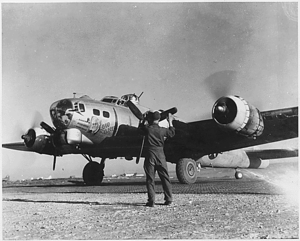
- Combat America: The B-17 Story — Watch real combat footage in color from WWII.
- Official site of the 95th "Fame's Favored Few" Bomb Group
- Official site of the 303rd "Hell's Angels" Bomb Group
- Official site of the 463rd "The Swoose" Bomb Group
- World War II 8th Air Force website
- Warbird Alley: B-17 page — Information about B-17s still flying today.
- Sam Hewitt: 15th Air Force WWII POW
- Lacey Lady — TheBomber.com
- The Most Unbelieveable Landing of a B-17
- The Air War in Retrospect — First-hand accounts of WWII Veterans.
- Lt. Bob Swan's Photos of Life as a B-17 Flying Fortress Navigator in England during WWII
- The Unforgettable Stories of Wally Hoffman, B-17 Pilot with the 8th AAF in England during WWII.
- Second-Lieutenant David Kingsley, the Ultimate Sacrifice
- Arizona Wing of the Commemorative Air Force & Their Touring B-17 — Sentimental Journey
- The Collings Foundation's Touring B-17 — Nine-0-Nine
- The EAA's Touring B-17 — Aluminum Overcast
- Fantasy of Flight's B17 — B-17 Flying Fortress on display at Fantasy of Flight.
- Battle-Damaged B-17s — Photographic chronicle of the damage that the "Queen of the Skies" could sustain and still bring her crews home.
Related content
Related development
Comparable aircraft
- Avro Lancaster
- B-24 Liberator
- Focke-Wulf Fw 200
- Handley-Page Halifax
- Heinkel He 177
- Junkers Ju 290
- Petlyakov Pe-8
- Piaggio P.108B
- Short Stirling
Designation sequence
- Military: XB-14 – XB-15 – XB-16 – B-17 – B-18 – XB-19 – Y1B-20
- Boeing: 266 – 281 – 294 – 299 – 300 – 307 – 314
Related lists
- List of B-17 Flying Fortress serial numbers
- List of bomber aircraft
- List of military aircraft of the United States
Lists relating to aviation | |
|---|---|
| General | Timeline of aviation · Aircraft · Aircraft manufacturers · Aircraft engines · Aircraft engine manufacturers · Airports · Airlines |
| Military | Air forces · Aircraft weapons · Missiles · Unmanned aerial vehicles (UAVs) · Experimental aircraft |
| Notable incidents and accidents | Military aviation · Airliners · General aviation · Famous aviation-related deaths |
| Records | Flight airspeed record · Flight distance record · Flight altitude record · Flight endurance record · Most produced aircraft |
da:B-17 Flying Fortress de:Boeing B-17 es:B-17 Flying Fortress fr:Boeing B-17 Flying Fortress gl:B-17 Flying Fortress it:Boeing B-17 Flying Fortress he:B-17 פליינג פורטרס nl:B-17 Flying Fortress ja:B-17 (爆撃機) no:Boeing B-17 Flying Fortress pl:Boeing B-17 Flying Fortress simple:B-17 Flying Fortress fi:B-17 Flying Fortress sv:Boeing B-17 Flying Fortress zh:B-17
